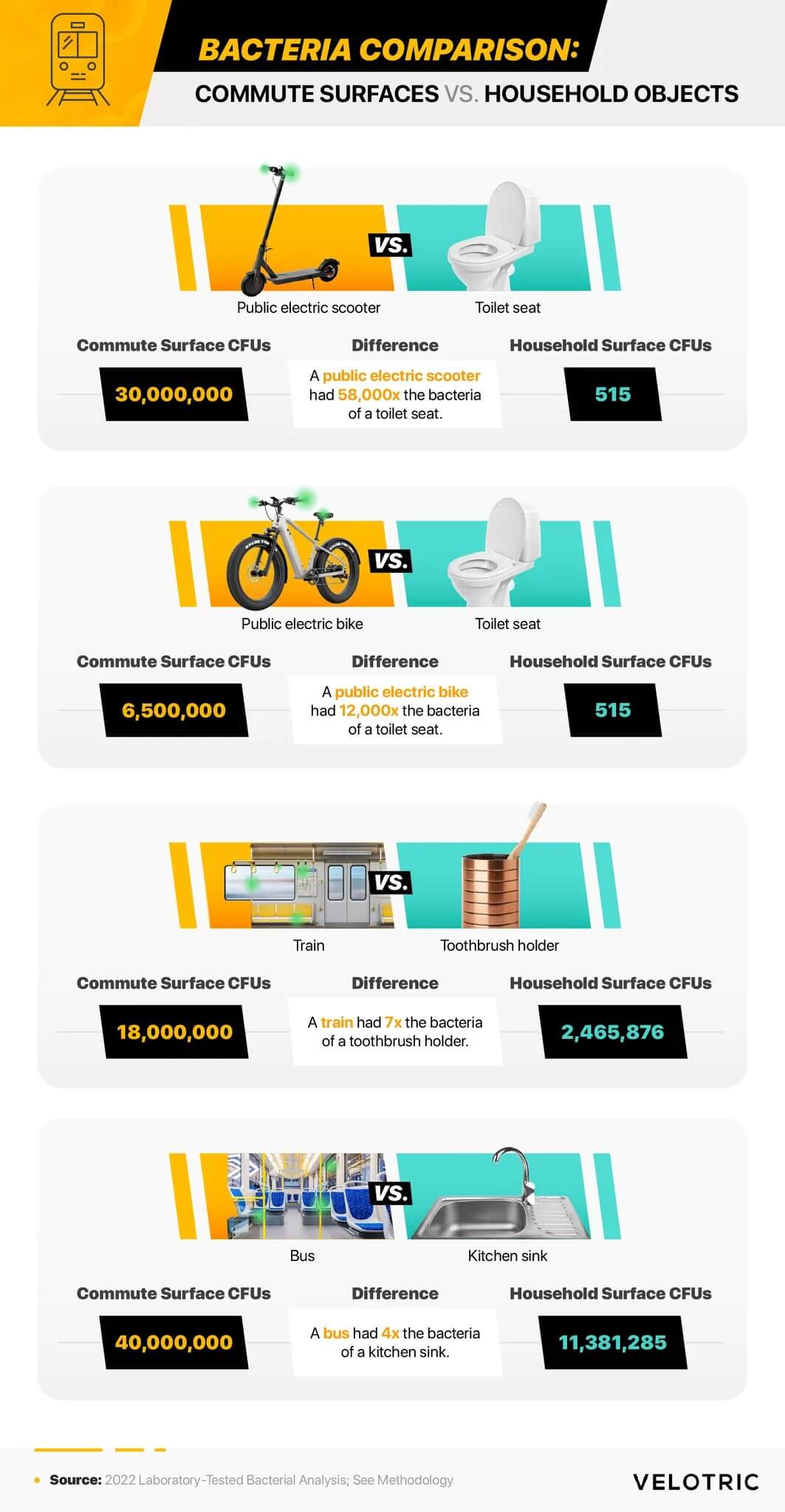
(Photo by Jonas Jacobsson on Unsplash)
New survey reveals alarming levels of bacteria in public transportation — and fitness clubs, too
CARSON, Calif. — Your everyday morning commute may be reflex at this point. If you hop on the subway or rent an electric bike or scooter, however, you may want to wear gloves from now on! Researchers looking at the amount of bacteria covering public transportation options say the typical public e-bike or scooter is also carrying thousands of times more germs than your average toilet!
The recent survey, commissioned by Velotric, found that publicly used objects in general are a less hygienic option than using your own equipment. In the case of public transport, the study reveals that a public electric bike carries 12,000 times the bacteria of a toilet seat and 800 times more bacteria than someone's personal electric bike.
While riding a public e-bike may be more common in some cities, riding a public electric scooter appears to be even worse for your health. Bacteria tests reveal that the average public e-scooter carries 700 times the bacteria of a personal electric scooter. That's 58,000 times more bacteria than what's sitting on a toilet seat!
“Because public scooters are probably not cleaned as often as bathrooms and are often left in public places, it makes sense that they could collect more bacteria. But whether you want to expose yourself to that bacteria is another question,” the researchers write in a statement.
Buses and trains aren't any cleaner
For people who take the train, avoid holding the subway handles! Researchers say commuter trains carry seven times the bacteria of a typical toothbrush holder. Specifically, the study says there's roughly 18 million colony-forming units (CFUs) crawling around on subway handles and seats. That grimy toothbrush holder only has 2.4 million.
Out of all public transportation services, however, the bus has the most microbial CFUs at 40 million. That's four times the amount of bacteria scientists say the average kitchen sink harbors. Next time you ride the bus, keep this in mind and bring your hand sanitizer — or a biohazard suit!
As for what kinds of germs commuters encounter on their daily journey, the study finds gram-positive rods are the most common lurking on e-scooters and trains. These germs can also cause severe disease. Meanwhile, gram-negative rods are the most bacteria on buses and e-bikes. This variety is an infection-causing bacteria that are highly resistant to antibiotics.
Public gyms are crawling with bacteria too
The findings go beyond just transportation. Researchers also studied exercise equipment like treadmills and yoga mats available for use at public gyms and compared them to bacteria found on household surfaces.
The findings are similarly alarming. The top two most bacteria-ridden surfaces in public gyms are exercise mats and weights. Public weights had 19 times more bacteria than a pet's tennis ball. “Think your dog’s mouth is cleaner than yours? Think again!” the researchers write.
When comparing public surfaces to their at-home counterparts, researchers found that public surfaces have significantly more bacteria. However, switching to use personal electric scooters, bikes, and cars as your mode of transport might be the way to go. The researchers also advise sanitizing both public and private gym equipment.
“Considering the sweat and grime they’re subjected to, you should disinfect them frequently and always wash up after a workout — especially now that you know what’s living on them.”
If having the luxury of an at-home gym or personal e-bike isn't realistic for you, researchers advise taking preventative measures like washing your hands frequently and sanitizing surfaces, especially when in public. According to a recent MIT study, if 60 percent of the world’s airport visitors washed their hands properly, the spread of viral infections would slow by 70 percent.
Study methodology:
Velotric researchers conducted three gram and stain culture swab tests across personal and public commute objects. Each surface was swabbed three times. CFUs per swab were averaged for each surface type. It is possible that with a larger sample size of surfaces, researchers could have gained more insight into CFU levels. No statistical testing was performed, and the above claims are based on means alone. As such, this content is exploratory. Bacteria definitions were sourced from ncbi.nlm.nih.gov, britannica.com, and sciencedirect.com.











